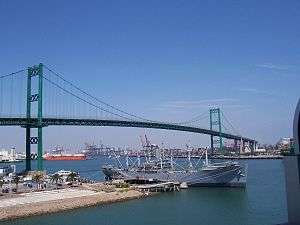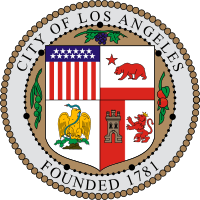Terminal Island
| Terminal Island Isla Raza de Buena Gente Rattlesnake Island | |
|---|---|
|
Terminal Island, which includes Federal Correctional Institution, Terminal Island. Gerald Desmond Bridge is also visible in the background. | |
 Terminal Island Location within Southern Los Angeles | |
| Coordinates: 33°45′25″N 118°14′53″W / 33.756963°N 118.248126°W | |
| Country | United States |
| State | California |
| County | Los Angeles |
| Cities | Los Angeles and Long Beach |
| ZIP Code | 90731 |
Terminal Island is a largely artificial island located in Los Angeles County, California, between the neighborhood of San Pedro in the city of Los Angeles, and the city of Long Beach. Terminal Island is roughly split between the Port of Los Angeles and Port of Long Beach. Land use on the island is entirely industrial and port-related, as well as the Federal Correctional Institution, Terminal Island.
History
The island was originally called Isla Raza de Buena Gente[1] and later Rattlesnake Island.[2] It was renamed Terminal Island in 1891.[1]
In 1909 the newly reincorporated Southern California Edison Company decided to build a new steam station to provide reserve capacity and emergency power for the entire Edison system, and to enable Edison to shut down some of its small, obsolete steam plants. The site chosen for the new plant was on a barren mudflat known as Rattlesnake Island, today's Terminal Island in Long Beach Harbor. Construction of Plant No. 1 began in 1910.
In 1930, the Ford Motor Company built a facility called Long Beach Assembly, having moved earlier operations from Downtown Los Angeles. The factory remained until 1958 when manufacturing operations were moved inland to Pico Rivera.
In 1927 a civilian facility, Allen Field, was established on Terminal Island. The Naval Reserve established a training center at the field and later took complete control, designating the field Naval Air Base San Pedro (also called Reeves Field).[3]:60 In 1941 the Long Beach Naval Station became located adjacent to the airfield. In 1942 the Naval Reserve Training Facility was transferred, and a year later NAB San Pedro's status was downgraded to a Naval Air Station (NAS Terminal Island). Reeves Field as a Naval Air Station was disestablished in 1947, although the adjacent Long Beach Naval Station would continue to use Reeves Field as an auxiliary airfield until the late 1990s.[4] A large industrial facility now covers the site of the former Naval Air Station.
The island was home to about 3,500 first- and second-generation Japanese Americans prior to World War II[5] in an area known as East San Pedro or Fish Island. Following the attack on Pearl Harbor, all of the adult Issei males on Terminal Island were incarcerated by the FBI on February 9, 1942. Immediately after the signing of Executive Order 9066 on February 19, 1942, the rest of the inhabitants were given 48 hours to evacuate their homes. They were subsequently sent to internment camps, and the entire neighborhood was razed. The Japanese community on Terminal Island was the first to be evacuated and interned en masse.[6]
Because of the relative geographical isolation of the island, the citizens developed their own culture and even their own dialect. After World War II, the Terminal Islanders settled elsewhere. In 1971, they formed the Terminal Islanders Club, which has organized various events for its members. In 2002, the surviving second-generation citizens set up a memorial on Terminal Island to honor their parents.
During World War II, Terminal Island was an important center for defense industries, especially shipbuilding. It was also, therefore, one of the first places where African Americans tried to effect their integration into defense-related work on the West Coast.[7]
In 1946, Howard Hughes moved his monstrous Spruce Goose airplane from his plant in Culver City to Terminal Island in preparation for its test flight. In its first and only flight, it took off from the island on November 2, 1947.[8]
Preservation of vacant buildings earned the island a spot on the top 11 sites on the National Trust for Historic Preservation's 2012 Most Endangered Historic Places List.[9] In mid-2013, the Los Angeles Board of Harbor Commissioners approved a preservation plan.[10] The National Trust for Historic Preservation cited the site as one of ten historic sites saved in 2013.[10]
Geography and demographics
The west half of the island is part of the San Pedro area of the city of Los Angeles, while the rest is part of the city of Long Beach. The island has a land area of 11.56 km2 (4.46 sq mi), or 2,854 acres (11.55 km2), and had a population of 1,467 at the 2000 census.
The land area of Terminal Island has been supplemented considerably from its original size. For instance, in the late 1920s, Deadman's Island in the main channel of the Port of Los Angeles was dynamited and dredged away, and the resulting rubble was used to add 62 acres (0.097 sq mi) to the island's southern tip.[3]:57
The Port of Los Angeles and the Port of Long Beach are the major landowners on the island, who in turn lease much of their land for container terminals and bulk terminals. The island also hosts canneries, shipyards, Coast Guard facilities, and a federal correctional institution.
The Long Beach Naval Shipyard, decommissioned in 1997, occupied roughly half of the island. Sea Launch maintains docking facilities on the mole that was part of the naval station.
Bridges
Terminal Island is connected to the mainland via four bridges.[11] To the west, the distinctive green Vincent Thomas Bridge, the fourth-longest suspension bridge in California, connects it with the Los Angeles neighborhood of San Pedro. The Gerald Desmond Bridge connects the island with downtown Long Beach to the east. The Commodore Schuyler F. Heim Bridge joins Terminal Island with the Los Angeles neighborhood of Wilmington to the north. Adjacent to the Heim Bridge is a rail bridge called the Henry Ford Bridge, or the Badger Avenue Bridge.[11]
See also
References
- 1 2 Laura Pulido; Laura Barraclough; Wendy Cheng (24 March 2012). A People's Guide to Los Angeles. University of California Press. p. 250. ISBN 978-0-520-95334-5. Retrieved 16 August 2012.
- ↑ Gerrie Schipske (31 October 2011). Early Long Beach. Arcadia Publishing. p. 93. ISBN 978-0-7385-7577-3. Retrieved 16 August 2012.
- 1 2 Michael D. White (13 February 2008). The Port of Los Angeles. Arcadia Publishing. pp. 57–60. ISBN 978-0-7385-5609-3. Retrieved 16 August 2012.
- ↑ Mark Denger. "Historic California Posts: Naval Air Station, Terminal Island". Retrieved August 16, 2012.
- ↑ Tetsuden Kashima (1997). Personal Justice Denied: Report of the Commission on Wartime Relocation and Internment of Civilians. University of Washington Press. p. 108. ISBN 978-0-295-97558-0. Retrieved 16 August 2012.
- ↑ Brian Niiya; Japanese American National Museum (Los Angeles, Calif.) (1993). Japanese American History: An A-To-Z Reference from 1868 to the Present. VNR AG. p. 327. ISBN 978-0-8160-2680-7. Retrieved 16 August 2012.
- ↑ Josh Sides (12 June 2006). L.A. City Limits: African American Los Angeles from the Great Depression to the Present. University of California Press. p. 64. ISBN 978-0-520-24830-4. Retrieved 16 August 2012.
- ↑ Darwin Porter (30 March 2005). Howard Hughes: Hell's Angel. Blood Moon Productions, Ltd. pp. 710–11. ISBN 978-0-9748118-1-9. Retrieved 16 August 2012.
- ↑ "LA Port Plan Makes Terminal Island Preservation a Key Goal". National Trust for Historic Preservation. Retrieved January 19, 2014.
- 1 2 staff (January 5, 2014). "A look at 10 historic sites save, 10 lost in 2013". Associated Press as reported by the Post Crescent. p. F3.
- 1 2 Daniel Z. Sui (19 June 2008). Geospatial Technologies and Homeland Security: Research Frontiers and Future Challenges. Springer. p. 42. ISBN 978-1-4020-8339-6. Retrieved 16 August 2012.
- Hirahara, Naomi (2014). Terminal Island: Lost Communities of Los Angeles Harbor. Santa Monica, Calif.: Angel City Press. ISBN 9781626400184.
- Regan, Lucile Cattermole (2006). The Red Lacquer Bridge. Bloomington, Ind.: AuthorHouse. ISBN 9781425983277.
External links
| Wikimedia Commons has media related to Terminal Island. |
- Furusato – The Lost Village of Terminal Island Website
- National Park Service: A History of Japanese Americans in California: Terminal Island
- The Bridges of Terminal Island (CA 47, CA 103)
 |
Harbor City – I-110 | Wilmington | Long Beach I-710 |  |
| Port of Los Angeles & San Pedro | |
Long Beach Port of Long Beach | ||
| ||||
| | ||||
| San Pedro | Pacific Ocean Santa Catalina Island |
Pacific Ocean |
Coordinates: 33°45′25″N 118°14′53″W / 33.756963°N 118.248126°W


